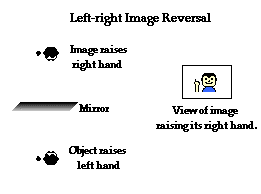
Can someone please explain these to me? Is the correct answer B?


Can someone please explain these to me? Is the correct answer B?
A mirror image is
Points (3) and (4) are correct. D is the answer.
NB: points (2) and (4) are the tricky statements.
The answer (B) should be correct.
Look for the explanation below.
In the case of plane mirrors, the image is said to be a virtual image. Virtual images are images that are formed in locations where light does not actually reach. Light does not actually pass through the location on the other side of the mirror; it only appears to an observer as though the light is coming from this location. Whenever a mirror (whether a plane mirror or otherwise) creates an image that is virtual, it will be located behind the mirror where light does not really come from. Later in this unit, we will study instances in which real images are formed by curved mirrors. Such images are formed on the same side of the mirror as the object and light passes through the actual image location.
That is why choice (1) The image is real is wrong.
Besides the fact that plane mirror images are virtual, there are several other characteristics that are worth noting. The second characteristic has to do with the orientation of the image.  If you view an image of yourself in a plane mirror (perhaps a bathroom mirror), you will quickly notice that there is an apparent left-right reversal of the image. That is, if you raise your left hand, you will notice that the image raises what would seem to be it’s right hand. If you raise your right hand, the image raises what would seem to be its left hand. This is often termed left-right reversal. This characteristic becomes even more obvious if you wear a shirt with lettering. For example, a shirt displaying the word “NIKE” will read “EKIN” when viewed in the mirror; a shirt displaying the word “ILLINOIS” will read “SIONILLI;” and a shirt displaying the word “BOB” will read “BOB.” (NOTE: Not only will the order of letters appear reversed, the actual orientation of the letters themselves will appear reversed as well. Of course, this is a little difficult to do when typing from a keyboard.) While there is an apparent left-right reversal of the orientation of the image, there is no top-bottom vertical reversal. If you stand on your feet in front of a plane mirror, the image does not stand on its head. Similarly, the ceiling does not become the floor. The image is said to be upright, as opposed to inverted.
If you view an image of yourself in a plane mirror (perhaps a bathroom mirror), you will quickly notice that there is an apparent left-right reversal of the image. That is, if you raise your left hand, you will notice that the image raises what would seem to be it’s right hand. If you raise your right hand, the image raises what would seem to be its left hand. This is often termed left-right reversal. This characteristic becomes even more obvious if you wear a shirt with lettering. For example, a shirt displaying the word “NIKE” will read “EKIN” when viewed in the mirror; a shirt displaying the word “ILLINOIS” will read “SIONILLI;” and a shirt displaying the word “BOB” will read “BOB.” (NOTE: Not only will the order of letters appear reversed, the actual orientation of the letters themselves will appear reversed as well. Of course, this is a little difficult to do when typing from a keyboard.) While there is an apparent left-right reversal of the orientation of the image, there is no top-bottom vertical reversal. If you stand on your feet in front of a plane mirror, the image does not stand on its head. Similarly, the ceiling does not become the floor. The image is said to be upright, as opposed to inverted.
Therefore choice (2) is incorrect and choice (3) is correct in this case.
A third characteristic of plane mirror images pertains to the relationship between the object’s distance to the mirror and the image’s distance to the mirror. For plane mirrors, the object distance (often represented by the symbol do) is equal to the image distance (often represented by the symbol di). That is the image is the same distance behind the mirror as the object is in front of the mirror. If you stand a distance of 2 meters from a plane mirror, you must focus at a location 2 meters behind the mirror in order to view your image.
Therefore, choice (4) is incorrect.
Hope that helps.
To find all the characteristics of a plane mirror, you can actually read up in http://www.physicsclassroom.com/class/refln/Lesson-2/Image-Characteristics, I found the explanation all in this website.